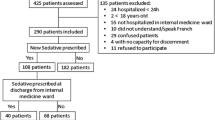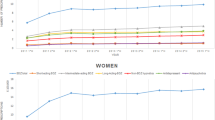Abstract
Aim
To describe trends in and characteristics of sedative drug use from 2000 through 2019 in relation to the introduction of central regulations and new drugs.
Methods
In this descriptive study, we used individual prescription data on the entire Danish population from the Danish National Prescription Registry to calculate yearly incidence and prevalence of use of benzodiazepines, benzodiazepine-related drugs (Z-drugs), melatonin, olanzapine, low-dose quetiapine, mianserin/mirtazapine, pregabalin, and promethazine from 2000 through 2019. From the Danish National Patient Registry, we obtained data on drug users’ psychiatric and somatic comorbidity.
Results
The use of benzodiazepines and Z-drugs declined gradually from 2000 through 2019, whereas the newer alternatives, melatonin, low-dose quetiapine, pregabalin and promethazine, increased in use, while the use of olanzapine and mianserin/mirtazapine was relatively stable. This development was seen in both men and women and across all age groups except for hypnotic benzodiazepines which showed a steep increase in the oldest age group from 2010. For all sedative drugs depression, anxiety, alcohol and misuse disorder, pain and cancer were the most prevalent comorbidities. During our study period, the number of individuals without any of the selected diagnoses increased.
Conclusion
In Denmark different central regulations have influenced prescription practice toward more restrictive use of Z-drugs and benzodiazepines, except for hypnotic benzodiazepine prescriptions increased after the introduction of special palliative care. An increase in use of newer sedative drugs, however, indicates that the regulations do not remove the need for sedative drugs in the population.




Similar content being viewed by others
Data availability
The data that support the findings of this study are available from Statistics Denmark. Restrictions apply to the availability of these data, which were used under license for this study.
References
Riemann D, Baglioni C, Bassetti C et al (2017) European guideline for the diagnosis and treatment of insomnia. J Sleep Res 26:675–700
Modesto-Lowe V, Harabasz AK, Walker SA (2021) Quetiapine for primary insomnia: consider the risks. Cleve Clin J Med 88:286–294
Lader M (1991) History of benzodiazepine dependence. J Subst Abuse Treat 8:53–59
Schmitz A (2016) Benzodiazepine use, misuse, and abuse: a review. Ment Health Clin 6:120–126
Gunja N (2013) The clinical and forensic toxicology of Z-drugs. J Med Toxicol 9:155–162
Marsden J, White M, Annand F et al (2019) Medicines associated with dependence or withdrawal: a mixed-methods public health review and national database study in England. Lancet Psychiatry 6:935–950
Schifano F, Chiappini S, Corkery JM et al (2019) An insight into Z-drug abuse and dependence: an examination of reports to the european medicines agency database of suspected adverse drug reactions. Int J Neuropsychopharmacol 22:270–277
Kurko TAT, Saastamoinen LK, Tähkäpää S et al (2015) Long-term use of benzodiazepines: definitions, prevalence and usage patterns—a systematic review of register-based studies. Eur Psychiatry 30:1037–1047
Janhsen K, Roser P, Hoffmann K (2015) The problems of long-term treatment with benzodiazepines and related substances. Dtsch Arzteblatt Int 112:1–7
Kripke DF, Langer RD, Kline LE (2012) Hypnotics’ association with mortality or cancer: a matched cohort study. BMJ Open 2:e000850
Crowe SF, Stranks EK (2018) The residual medium and long-term cognitive effects of benzodiazepine use: an updated meta-analysis. Arch Clin Neuropsychol 33:901–911
Andersen LPH, Gögenur I, Rosenberg J et al (2016) The safety of melatonin in humans. Clin Drug Investig 36:169–175
Schwartz TL, Stahl SM (2011) Treatment strategies for dosing the second generation antipsychotics. CNS Neurosci Ther 17:110–117
Højlund M, Pottegård A, Johnsen E et al (2019) Trends in utilization and dosing of antipsychotic drugs in Scandinavia: comparison of 2006 and 2016. Br J Clin Pharmacol 85:1598–1606
Kamphuis J, Taxis K, Schuiling-Veninga CCM et al (2015) Off-label prescriptions of low-dose quetiapine and mirtazapine for insomnia in The Netherlands. J Clin Psychopharmacol 35:468–470
Di Iorio G, Matarazzo I, Di Tizio L et al (2013) Treatment-resistant insomnia treated with pregabalin. Eur Rev Med Pharmacol Sci 17:1552–1554
Höjer J, Tellerup M (2018) Renässans för Lergigan med kraftig ökning av intoxikationsfall. Läkartidningen 115:E9EZ
Lægemiddelstyrelsen (2014) Antihistaminet promethazin (Phernergan) bliver receptpligtigt. https://laegemiddelstyrelsen.dk/da/nyheder/2014/antihistaminet-promethazin-phenergan-mfl-bliver-receptpligtigt/
Pedersen CB, Gotzsche H, Moller JO et al (2006) The Danish civil registration system. A cohort of eight million persons. Dan Med Bull 53:441–9
Pottegård A, Schmidt SAJ, Wallach-Kildemoes H et al (2017) Data resource profile: the Danish national prescription registry. Int J Epidemiol 46:798–798f
Højlund M, Lund LC, Andersen K et al (2021) Association of low-dose quetiapine and diabetes. JAMA Netw Open 4:e213209
Alvim MM, Cruz DT, Vieira MT et al (2017) Prevalence of and factors associated with benzodiazepine use in community-resident elderly persons. Rev Bras Geriatr E Gerontol 20:463–473
Kassam A, Patten SB (2006) Hypnotic use in a population-based sample of over thirty-five thousand interviewed Canadians. Popul Health Metr 4:15
Kuo C-L, Chien I-C, Lin C-H (2022) Trends, correlates, and disease patterns of sedative-hypnotic use among elderly persons in Taiwan. BMC Psychiatry 22:316
Højlund M, Andersen JH, Andersen K et al (2021) Use of antipsychotics in Denmark 1997–2018: a nation-wide drug utilisation study with focus on off-label use and associated diagnoses. Epidemiol Psychiatr Sci 30:e28
Evoy KE, Sadrameli S, Contreras J et al (2021) Abuse and misuse of pregabalin and gabapentin: a systematic review update. Drugs 81:125–156
Methods to analyse medicine utilization and expenditure to support pharmaceutical policy implementation. WHO. https://apps.who.int/iris/bitstream/handle/10665/274282/9789241514040-eng.pdf?sequence=1&isAllowed=y
Hallas J, Gaist D, Bjerrum L (1997) The waiting time distribution as a graphical approach to epidemiologic measures of drug utilization. Epidemiology 8:666
Cadogan CA, Ryan C, Cahir C et al (2018) Benzodiazepine and Z-drug prescribing in Ireland: analysis of national prescribing trends from 2005 to 2015. Br J Clin Pharmacol 84:1354–1363
Okui T, Park J, Hirata A et al (2021) Trends in the prescription of benzodiazepine receptor agonists from 2009 to 2020: a retrospective study using electronic healthcare record data of a university hospital in Japan. Healthc Basel Switz 9:1724
Begum M, Gonzalez-Chica D, Bernardo C et al (2021) Trends in the prescription of drugs used for insomnia: an open-cohort study in Australian general practice, 2011–2018. Br J Gen Pract 71:e877–e886
Wesselhoeft R, Rasmussen L, Jensen PB et al (2021) Use of hypnotic drugs among children, adolescents, and young adults in Scandinavia. Acta Psychiatr Scand 144:100–112
Frase L, Nissen C, Riemann D et al (2018) Making sleep easier: pharmacological interventions for insomnia. Expert Opin Pharmacother 19:1465–1473
Carpenter JK, Andrews LA, Witcraft SM et al (2018) Cognitive behavioral therapy for anxiety and related disorders: a meta-analysis of randomized placebo-controlled trials. Depress Anxiety 35:502–514
Jørgensen M, Videbech P, Osler M (2017) Benzodiazepiner har fortsat en plads i moderne psykiatrisk behandling. Ugeskr Laeger 179:2133–2137
Ferracioli-Oda E, Qawasmi A, Bloch MH (2013) Meta-analysis: melatonin for the treatment of primary sleep disorders. PLoS ONE 8:e63773
Buscemi N, Vandermeer B, Friesen C et al (2007) The efficacy and safety of drug treatments for chronic insomnia in adults: a meta-analysis of RCTs. J Gen Intern Med 22:1335–1350
Mukai R, Hasegawa S, Umetsu R et al (2019) Evaluation of pregabalin-induced adverse events related to falls using the FDA adverse event reporting system and Japanese Adverse Drug Event Report databases. J Clin Pharm Ther 44:285–291
Bonnet U, Scherbaum N (2017) How addictive are gabapentin and pregabalin? A systematic review. Eur Neuropsychopharmacol 27:1185–1215
Russell IJ, Crofford LJ, Leon T et al (2009) The effects of pregabalin on sleep disturbance symptoms among individuals with fibromyalgia syndrome. Sleep Med 10:604–610
Landolt S, Rosemann T, Blozik E et al (2021) Benzodiazepine and Z-drug use in Switzerland: prevalence, prescription patterns and association with adverse healthcare outcomes. Neuropsychiatr Dis Treat 17:1021–1034
Funding
No funding was received for conducting this study.
Author information
Authors and Affiliations
Corresponding author
Ethics declarations
Conflict of interest
The authors declare no conflicts of interests.
Supplementary Information
Below is the link to the electronic supplementary material.
Rights and permissions
Springer Nature or its licensor (e.g. a society or other partner) holds exclusive rights to this article under a publishing agreement with the author(s) or other rightsholder(s); author self-archiving of the accepted manuscript version of this article is solely governed by the terms of such publishing agreement and applicable law.
About this article
Cite this article
Rosenqvist, T.W., Osler, M., Wium-Andersen, M.K. et al. Sedative drug-use in Denmark, 2000 to 2019: a nationwide drug utilization study. Soc Psychiatry Psychiatr Epidemiol 58, 1493–1502 (2023). https://doi.org/10.1007/s00127-022-02409-5
Received:
Accepted:
Published:
Issue Date:
DOI: https://doi.org/10.1007/s00127-022-02409-5




